Continuing our Flower Power series….Honeysuckle

Honeysuckle is a magical woodland shrub of the family Caprifoliaceae. Rather unromantically, the family name comes from the fact that goats love to eat these leaves – caprifolium is Latin for “goat’s leaf”. Its genus is Lonicera, named for the German botanist Adamus Lonicerus. There are over 150 species of Lonicera throughout the Northern Hemisphere with 9 of them native to Canada.
Honeysuckle can be semi-evergreen or deciduous, depending on the species. Plants within the genus Lonicera are often twisting vines but many are arching shrubs. Twisting vines have stems that spiral around stalks and branches of other plants or pole-like structures. Arching shrubs, instead of growing from a centralized trunk or stem, form clusters of arching stems that protrude from the ground within an area. The shrubs can reach up to 30 feet while the vines can climb as high as 30-80 feet. Both the shrubs and vines have strong and fibrous stems traditionally used for making bindings and for clothing.
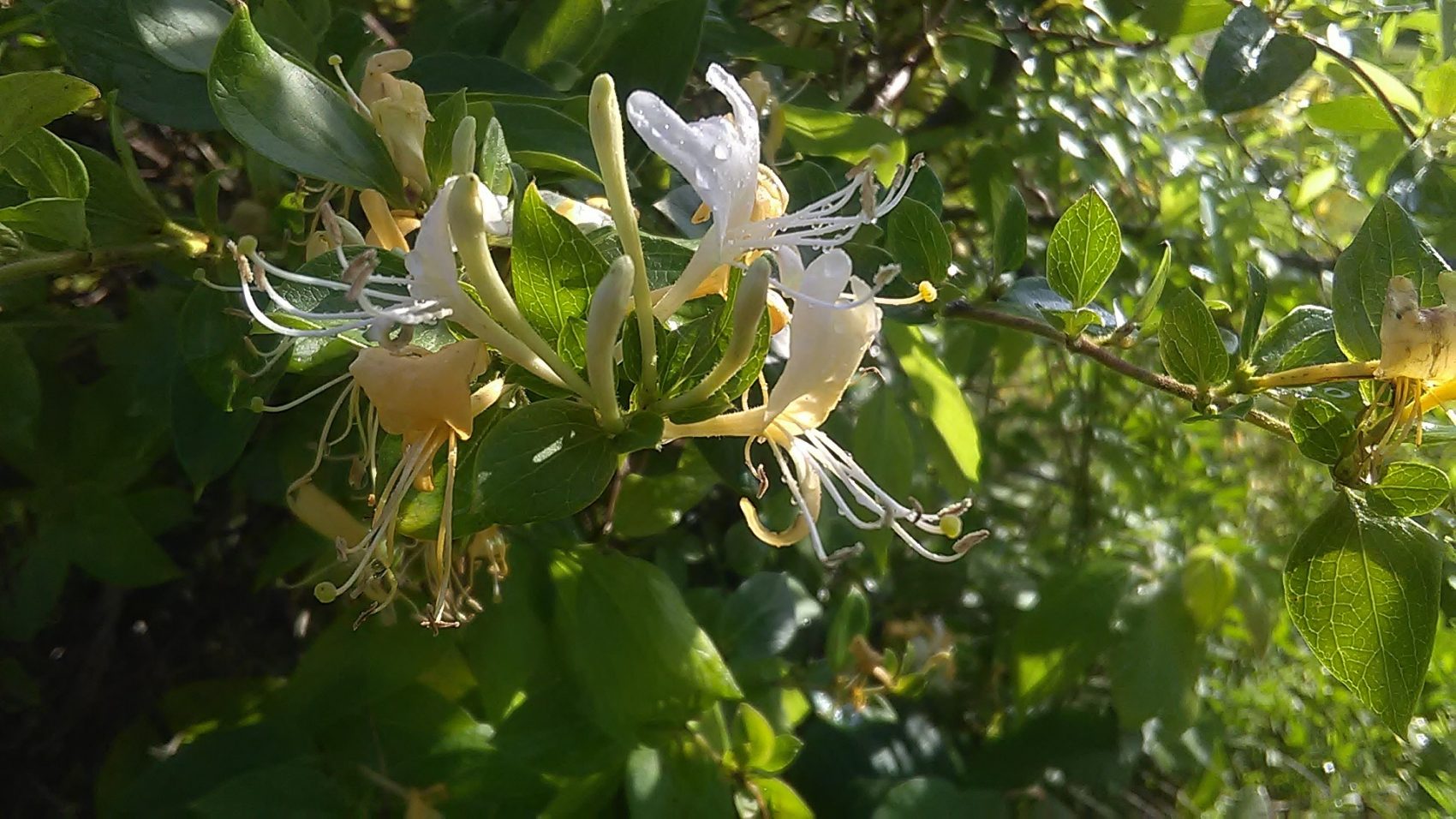
The common name “honeysuckle” comes from the delight children of all ages sucking the nectar from the base of the flower. Domestic honeysuckle (such as pictured above) originate in Europe. They are gorgeous, but tend to be aggressive. Care must be taken to keep them under control so they don’t become invasive. Properly pruned, they make wonderful privacy screens and hedges, adding vertical interest to gardens. Honeysuckle’s delicate, sweet blossoms and vibrant colors have made them a beloved addition to gardens and landscapes around the world.
The small, oval leaves of Honeysuckle can be dark green to bluish-green, arranged in opposites along the branches. Their tubular or trumpet-shaped flowers have a long blooming period from late spring to early fall.
The flowers are usually arranged in pairs and vibrantly colored with white, yellow, orange, pink or red. Some of the white flowers change to yellow once pollination has been achieved. An apparent favorite of cats, who love playing with the flowers. Perhaps they are attracted to the scent which is particularly prominent at night.
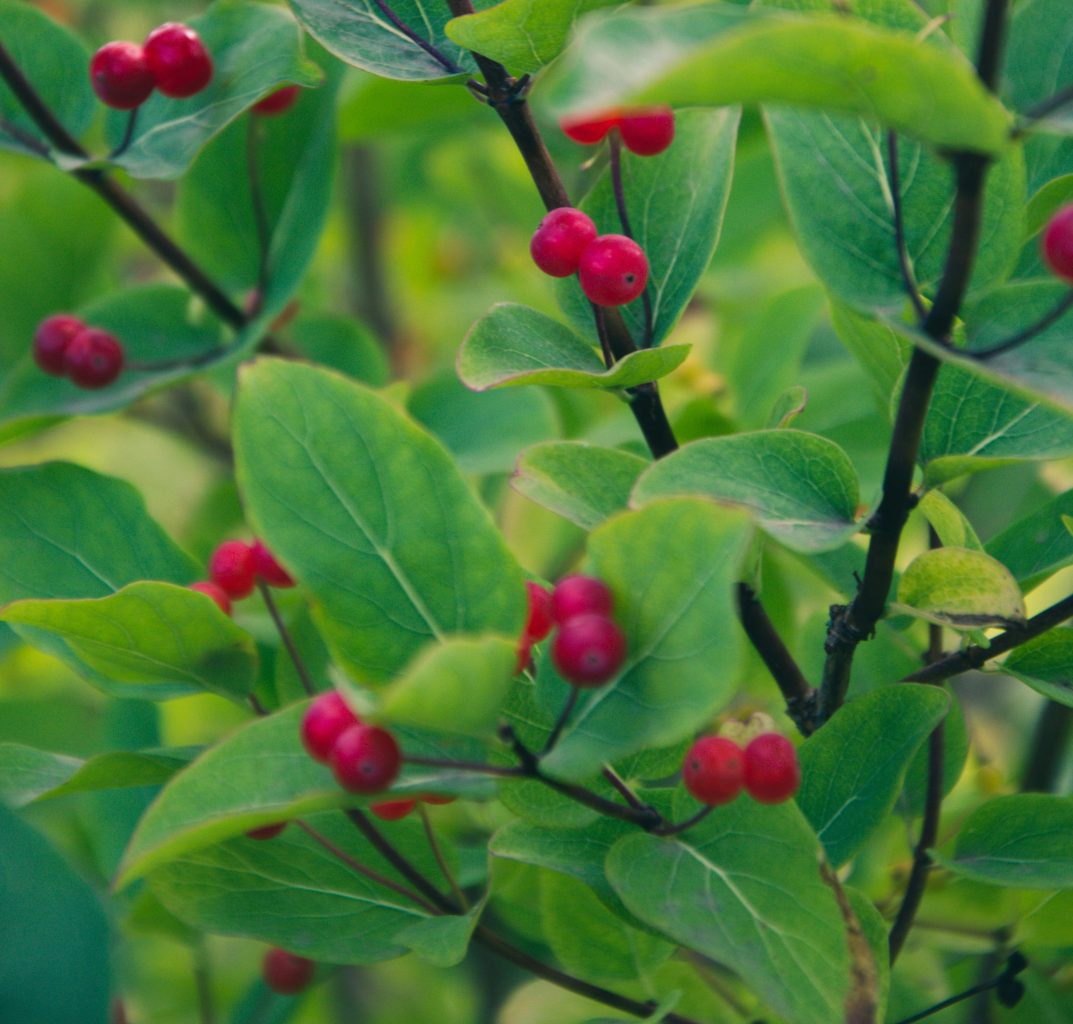
The fruit of Honeysuckle are round or elongated and the colors range from orange/red to blue/black. They usually contain just a few seeds. For humans, this is the part of the plant they should not consume because it contains substances which induces nausea and vomiting. For bears, birds and other wildlife it is a safe source of food. Knowledgeable Indigenous people utilized the fruit for digestive problems, as a tonic and as a source of dye.
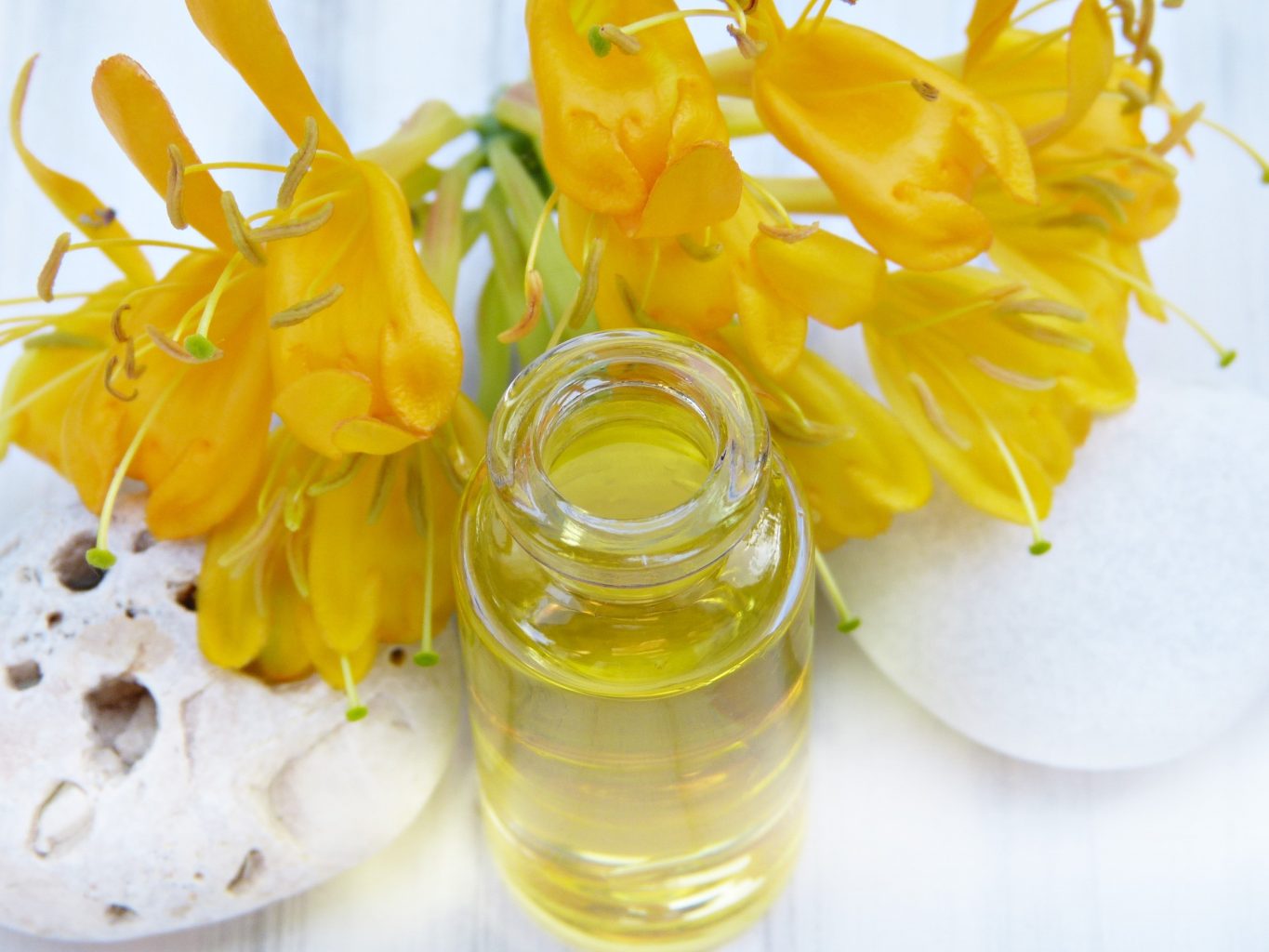
As noted, pleasing aesthetics are not Honeysuckle’s only attribute; they are edible, medicinal and more.
The species L. japonica is grown commercially for use in Traditional Chinese Medicine. For centuries it has been used to treat various ailments. The cooling properties are used to alleviate fever and inflammation. These anti-inflammatory properties also make it a popular ingredient in natural skincare products.
Honeysuckle adds scent to Chinese teas in a manner popularized in the Qing dynasty. In modern times the dried flowers and leaves of Honeysuckle are often used to make herbal teas which are both delicious and have potential health benefits. The leaves can also be consumed as a leafy vegetable.
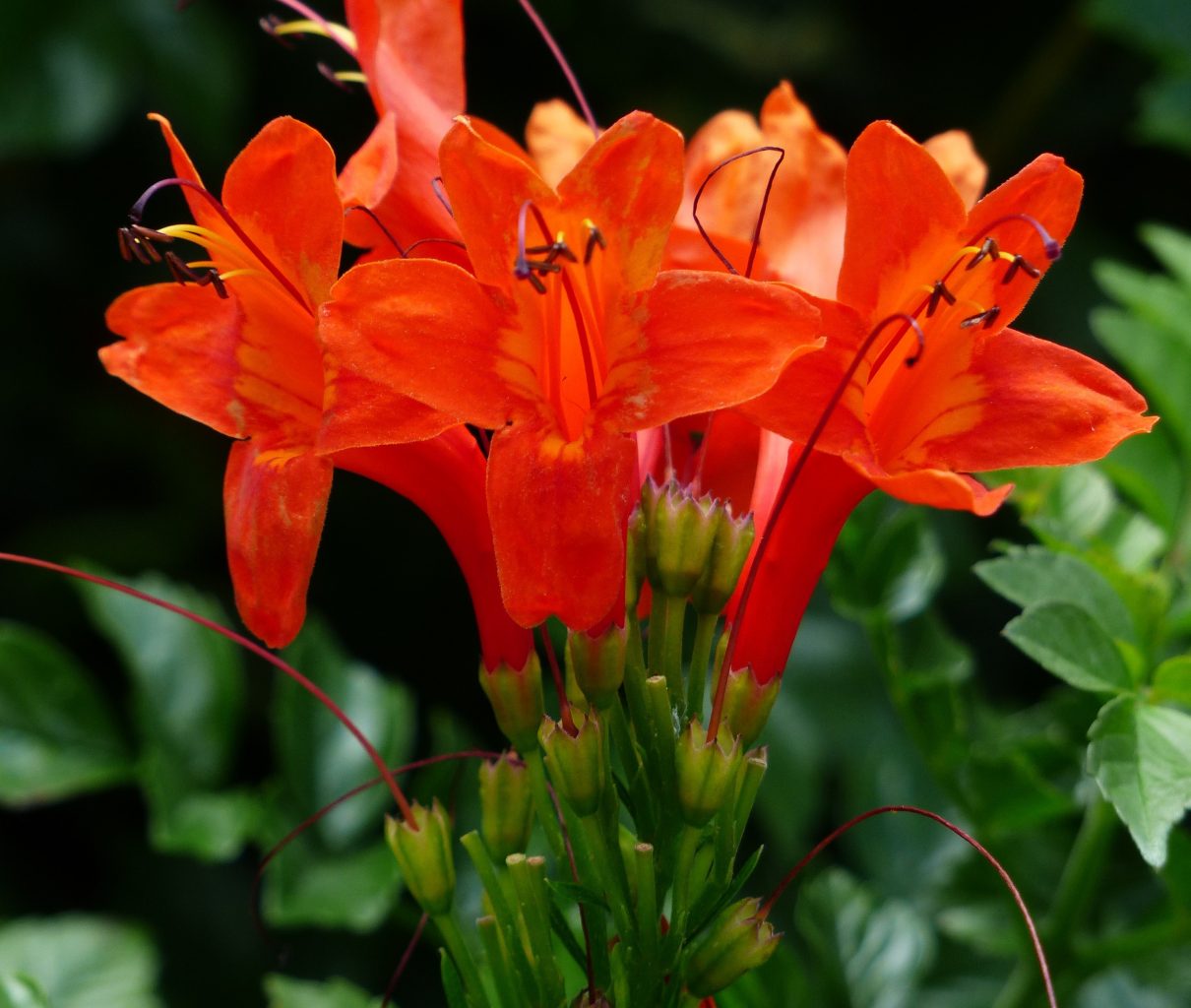
A medieval Irish poem tells the story of the king of fairies informing the ruler of Ulster which trees could be used for firewood, making it clear that there would be dire consequences for anyone who used the lovely honeysuckle in a fire. His warning included descriptions of misfortune at weapon-point or drowning in great waves.
The magical qualities of Honeysuckle (which they referred to as “woodbine”) were carried into the late 19th century Scotland as the “wise women” passed consumptive invalids and children with “hectic fever” 3 times through a circular wreath of Honeysuckle (which needed to be cut during the waxing March moon). They would guide the wreath down over the body from head to foot, then cut it into 9 pieces and cast it into the fire.
The spiral growth of Honeysuckle onto straight branches of hazel and ash results in a lovely twisted look. When these branches were cut into walking sticks, they were highly prized in Sussex because it was believed they were a guarantee of good luck.

Orange honeysuckle (western trumpet, Lonicera ciliosa) is a high-climbing vine with branches that reach widely. Growing wild in open woods and deep forests from sea level to mid elevations, they can be found on the Pacific Coast of southern B.C. to Northern California and west into Montana. Indigenous peoples used the stem fibers of Orange Honeysuckle to make mats, blankets and capes. The stout vines were even used to reinforce suspension bridges.
The gorgeous orange trumpet flowers open from May until July and reddish-orange berries shine in late summer to early fall. They are not scented like other honeysuckles but do attract hummingbirds with their bright color. Orange Honeysuckle is easy to cultivate in your garden. Some invasive species tend to be too strong for their hosts, but not Orange Honeysuckle. It is a kinder, gentler vine that clambers lightly over shrubs.
One company wrote of their product: “Use Orange Wild Honeysuckle Flower Essence when you feel constantly revved, edgy, nervous, can’t slow down enough to be with yourself, and have difficulty sleeping. Orange Wild Honeysuckle Essence helps you to slow down the pace of your life, feel more comfortable in your body, and peacefully and calmly engaging life as your authentic self”.
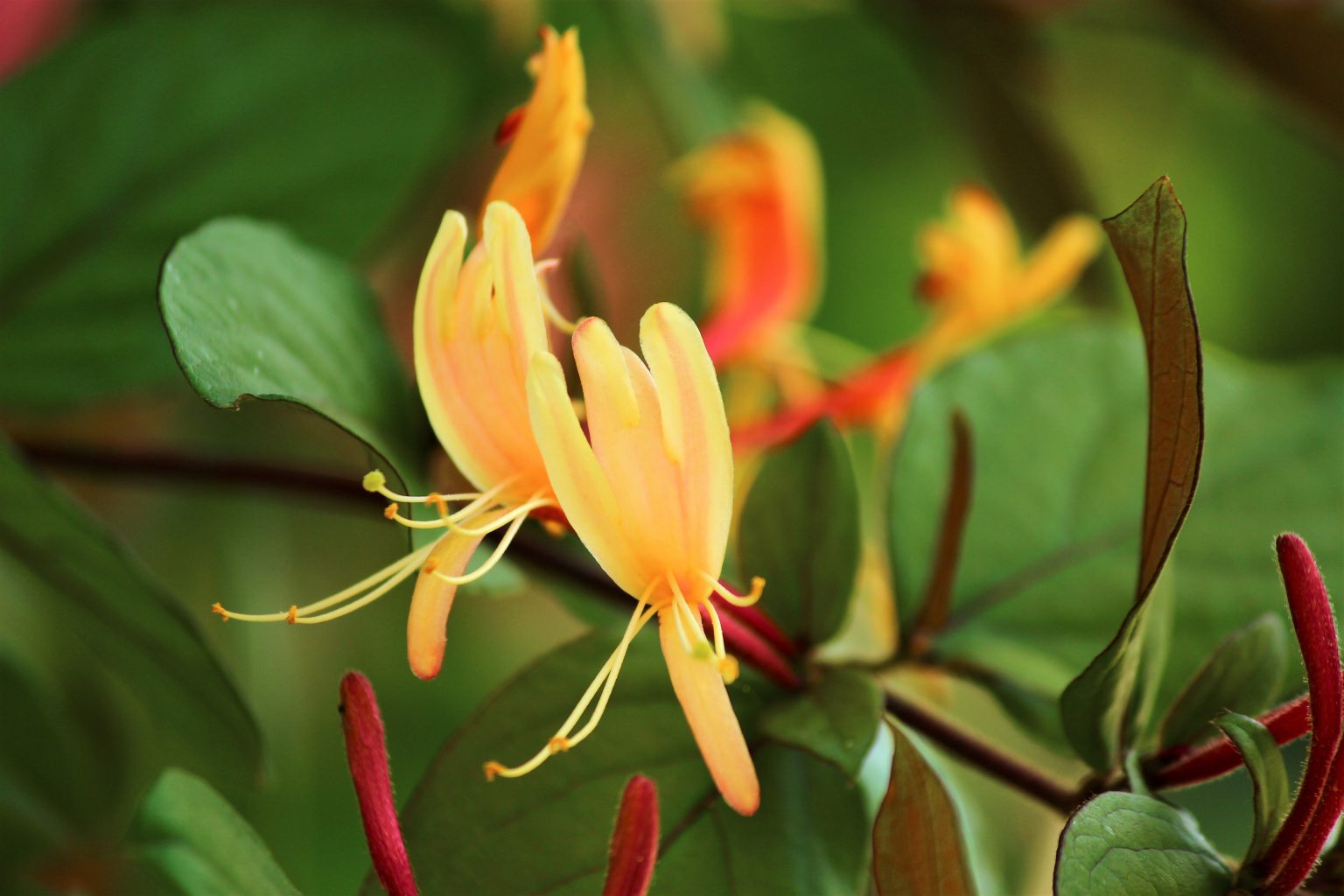
Much has been written on the symbolism of Honeysuckle, mostly with themes such as happiness, protection, luck, awareness, depending on the culture and geography. A happy subject for further research?
For those using these informational articles as inspiration for self-cultivation:
The value of walking the “middle road” in life is often mentioned in ancient writing. In practical life this infers ongoing adjustment of attitudes and actions because we humans tend to veer toward one extreme or other in the course of life. The ancients called this “stepping off your life path” and hasten to say this is not a bad thing, as long as one returns to their path.
It is this “middle road” that comes to mind while looking at the various species of Honeysuckle, their structure and activity. We see that even something as amazing as climbing vines full of gorgeous flowers can rest lightly or strangle their host foliage.
When the flowers first bloom, they offer a sweet treat of nectar and, in some cases, the whole flower can be eaten. But taken too far for too long the result is one could get sick from what the flower evolves into, the fruit (berry).
And finally, prolific growth is usually desired. Gardeners love how quickly the vines grow and flower in the spring. But too much of a “good” thing means there is the possibility that the growth will take over and endanger neighboring plants. Food for thought…
